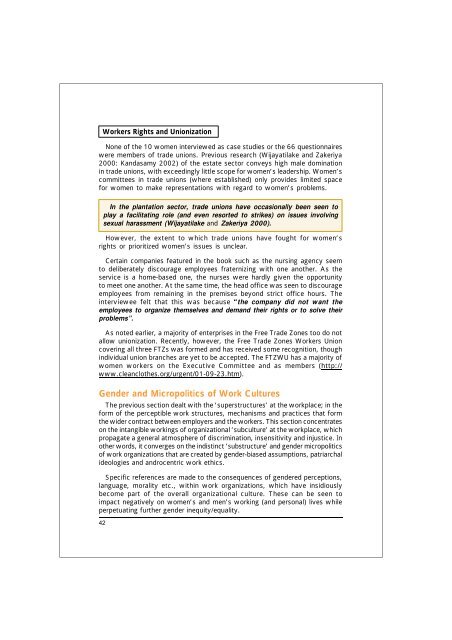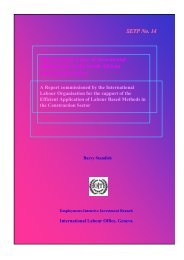Beyond Glass Ceilings and Brick Walls - International Labour ...
Beyond Glass Ceilings and Brick Walls - International Labour ...
Beyond Glass Ceilings and Brick Walls - International Labour ...
Create successful ePaper yourself
Turn your PDF publications into a flip-book with our unique Google optimized e-Paper software.
Workers Rights <strong>and</strong> Unionization<br />
None of the 10 women interviewed as case studies or the 66 questionnaires<br />
were members of trade unions. Previous research (Wijayatilake <strong>and</strong> Zakeriya<br />
2000: K<strong>and</strong>asamy 2002) of the estate sector conveys high male domination<br />
in trade unions, with exceedingly little scope for women’s leadership. Women’s<br />
committees in trade unions (where established) only provides limited space<br />
for women to make representations with regard to women’s problems.<br />
In the plantation sector, trade unions have occasionally been seen to<br />
play a facilitating role (<strong>and</strong> even resorted to strikes) on issues involving<br />
sexual harassment (Wijayatilake <strong>and</strong> Zakeriya 2000).<br />
However, the extent to which trade unions have fought for women’s<br />
rights or prioritized women’s issues is unclear.<br />
Certain companies featured in the book such as the nursing agency seem<br />
to deliberately discourage employees fraternizing with one another. As the<br />
service is a home-based one, the nurses were hardly given the opportunity<br />
to meet one another. At the same time, the head office was seen to discourage<br />
employees from remaining in the premises beyond strict office hours. The<br />
interviewee felt that this was because “the company did not want the<br />
employees to organize themselves <strong>and</strong> dem<strong>and</strong> their rights or to solve their<br />
problems”.<br />
As noted earlier, a majority of enterprises in the Free Trade Zones too do not<br />
allow unionization. Recently, however, the Free Trade Zones Workers Union<br />
covering all three FTZs was formed <strong>and</strong> has received some recognition, though<br />
individual union branches are yet to be accepted. The FTZWU has a majority of<br />
women workers on the Executive Committee <strong>and</strong> as members (http://<br />
www.cleanclothes.org/urgent/01-09-23.htm).<br />
Gender <strong>and</strong> Micropolitics of Work Cultures<br />
The previous section dealt with the ‘superstructures’ at the workplace; in the<br />
form of the perceptible work structures, mechanisms <strong>and</strong> practices that form<br />
the wider contract between employers <strong>and</strong> the workers. This section concentrates<br />
on the intangible workings of organizational ‘subculture’ at the workplace, which<br />
propagate a general atmosphere of discrimination, insensitivity <strong>and</strong> injustice. In<br />
other words, it converges on the indistinct ‘substructure’ <strong>and</strong> gender micropolitics<br />
of work organizations that are created by gender-biased assumptions, patriarchal<br />
ideologies <strong>and</strong> <strong>and</strong>rocentric work ethics.<br />
Specific references are made to the consequences of gendered perceptions,<br />
language, morality etc., within work organizations, which have insidiously<br />
become part of the overall organizational culture. These can be seen to<br />
impact negatively on women’s <strong>and</strong> men’s working (<strong>and</strong> personal) lives while<br />
perpetuating further gender inequity/equality.<br />
42
















